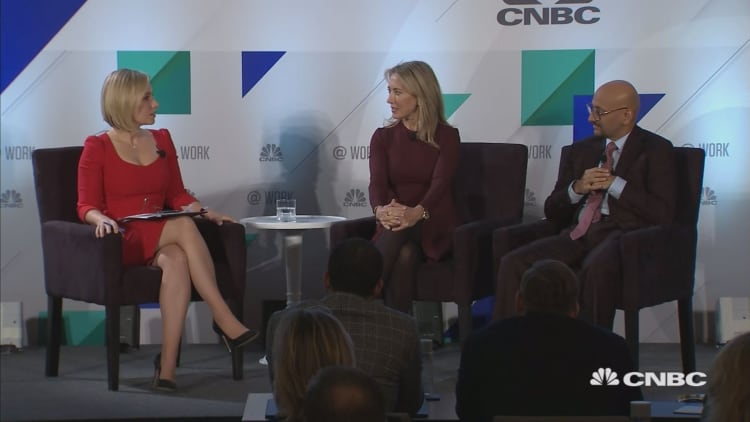When Google's director of ad marketing, Bethany Poole, prepared to take her second maternity leave, she knew she had to do something different. Though she praised Google's parental leave policy, she still struggled with taking time off as an executive.
"My first leave, there was no backfill, because we couldn't find somebody we could hire from outside. My male colleague covered both jobs, and it was awful," Poole recalled during a talk at the recent GALVANIZE conference.
The co-worker that covered for Poole did not get promoted and ended up leaving the group.
"Bad for me and bad for him," she said.
For her second leave, she decided to leverage Google's formalized "bungee" program, in which a full-time employee can take a different role in the company for several months to cover a leave of absence, with the expectation that the Googler will return to his or her previous team when the bungee is complete.
"I had a big team. I really didn't want to leave it. I built it from scratch; I wanted it to be successful. So I recruited a friend of mine who basically covered that for six months," Poole said.
That co-worker has since helped cover multiple other women's maternity leaves.
"She has three children, and she has helped five other women executives be successful as they balance family and work," said Poole at the New York City conference, which was hosted by the women's career community start-up Fairygodboss, on Oct. 16. Poole's children are now 4 and 7.
Besides covering for employees on leave like Poole, the same-site rotations also provide development opportunities because the person making the jump gains experience working on different teams. The idea has spread in the tech community as workers demand more work/life balance and greater professional development opportunities.
"The workforce is changing, and how people work is changing," said Debra Wheatman, a certified career coach and president of Careers Done Write. "A lot of people want to have a better work/life balance. They don't want to deal with the stress of wondering what's going on while they're gone and how that's going to impact their performance when they return."
Wheatman said she has seen an uptick in companies offering these cross-training initiatives, though not always as part of a formalized program.
How companies like Hootsuite are stretching
Canadian social media management company Hootsuite has taken the concept a step further by implementing a "stretch program" modeled partly on Google's bungees.
Year after year the company scored high in employee satisfaction surveys, yet despite the results, annual staff turnover was significant. After speaking to employees, Hootsuite CEO Ryan Holmes realized many people left because they wanted to try something new and be challenged in new roles and with different responsibilities.
A 2013 study from the University of North Carolina's Kenan-Flagler Business School also had stuck in Holmes' mind for years. It showed 65 percent of millennials saying personal development was the most important factor in their current job. Subsequent studies backed those findings up. In 2016, Gallup found 87 percent of millennials rated professional or career growth and development opportunities as important to them in a job, compared to 69 percent of non-millennials.
To give current employees the chance to try new positions within the company, Hootsuite's rotational development program allows top-performing employees to "stretch" into a specific project on another team for 20 percent of their work time, while remaining at their regular job the rest of the time, for a total of 90 days.

Brittany Ho, a customer advocacy specialist in Hootsuite's Vancouver office, participated in the stretch program a year ago because she wanted to learn more about other parts of the company. When she stretched from her role on the customer team to corporate development, Ho worked on a project to help decrease bias in the company's hiring process.
"I had a great, positive experience," said Ho. "I went into it just knowing this is a learning opportunity for me."
The stretch experience helped her understand the responsibilities of the corporate team, make strategic decisions and build relationships with different types of people.
"It's a really great learning opportunity especially because I think it's unrealistic that someone will be happy in their role for five years. So this is a really great way to learn about a different part of the business," Ho said.
The program has been a success, with leaders now pitching programs to lure talent to their teams, according to Hootsuite senior vice president of people Matthew Handford.
"What we want to do is provide career experience an employee would normally not get," said Handford. "The other big piece we're after is we're trying to build a culture within the organization and leadership team around sharing talent." He added, "We realize that learning needs to be a constant practice. Employees need to continually have leading-edge skills, which drives progression, which is one of the big aspects of retention we've found."
Hootsuite is expanding the Google-inspired concept to tackle the problem that Poole originally struggled to solve: covering maternity leaves. It is bringing the program to Singapore, which has a shorter maternity leave provision than other countries where Hootsuite has offices. Because the program is designed around the idea of offering employees short-term rotations, it would not make sense as a maternity-leave option in countries where the the leave periods are much longer, such as Canada.
Offering these types of opportunities, whether to cover leaves or encourage personal development, can help companies be places where people want to work. Wheatman said it is a missed opportunity for companies if they don't provide employees with growth opportunities, because these types of programs can help identify and retain top talent.
"When you provide people with these situations, the company is demonstrating that they are committed to their employees' growth and they are looking for ways to grow talent within," Wheatman said.





